Business Law Assignment: Contractual Terms and Estoppel
VerifiedAdded on 2023/04/19
|6
|1739
|421
Homework Assignment
AI Summary
This assignment analyzes four key legal issues within the realm of business law. The first question addresses whether representations made by a seller constitute terms of a contract, differentiating between puffery and actionable representations, referencing the case of Oscar Chess v Williams. The second issue examines the enforceability of an exclusion clause displayed at a sales counter, focusing on the requirement of reasonable notice, drawing on the cases of L'Estrange v F Graucob Ltd and Balmain New Ferry Co Ltd v Robertson. The third issue explores the application of promissory estoppel to prevent a party from reneging on a promise, referencing the case of Waltons Stores (Interstate) Ltd v Maher. The final issue concerns the validity of an exclusion clause on a receipt, emphasizing the need for reasonable notice, with reference to Causer v Brown. Each issue is analyzed using the IRAC method, applying relevant case law and legal principles to the facts presented.
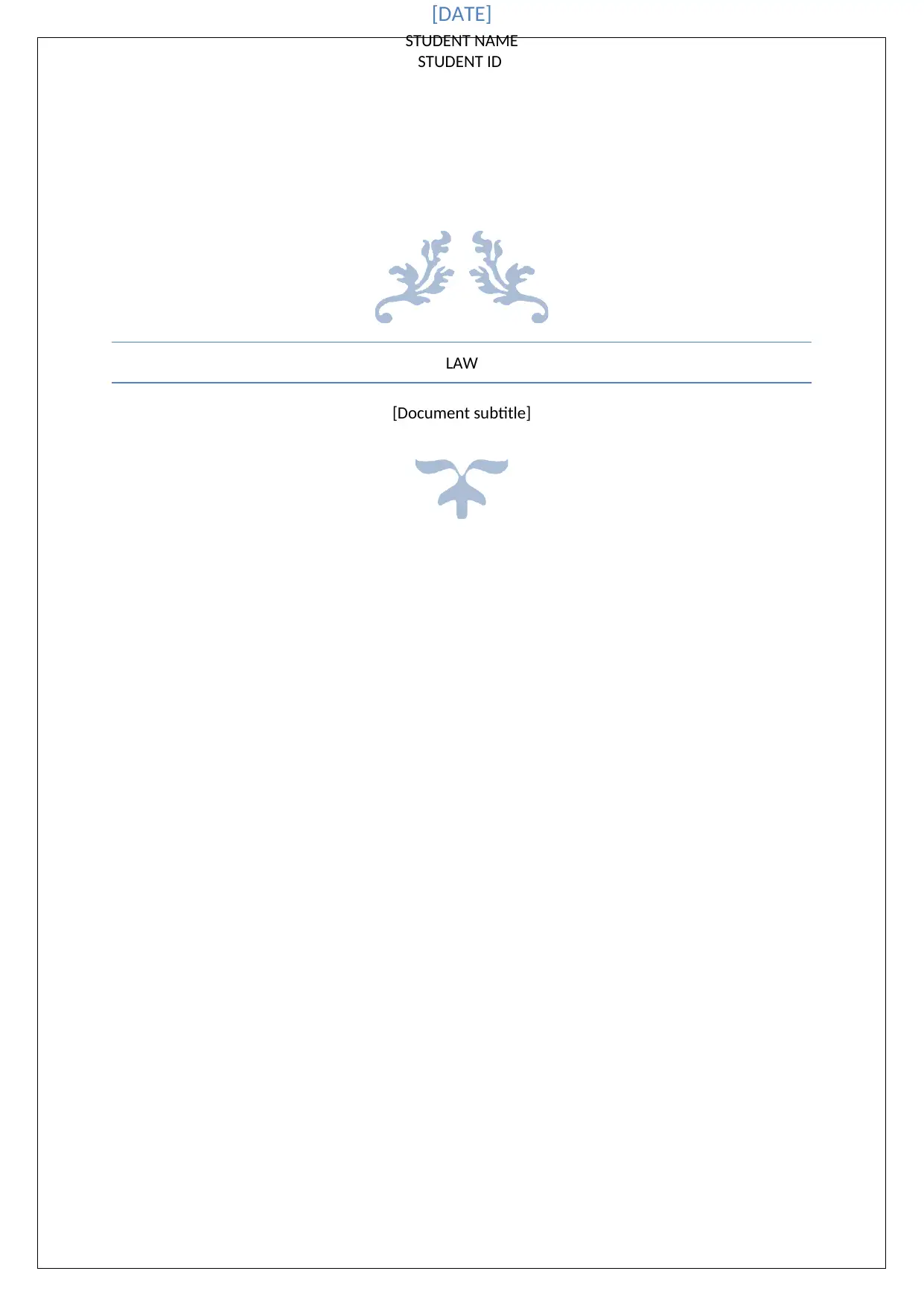
LAW
[Document subtitle]
[DATE]
STUDENT NAME
STUDENT ID
[Document subtitle]
[DATE]
STUDENT NAME
STUDENT ID
Paraphrase This Document
Need a fresh take? Get an instant paraphrase of this document with our AI Paraphraser
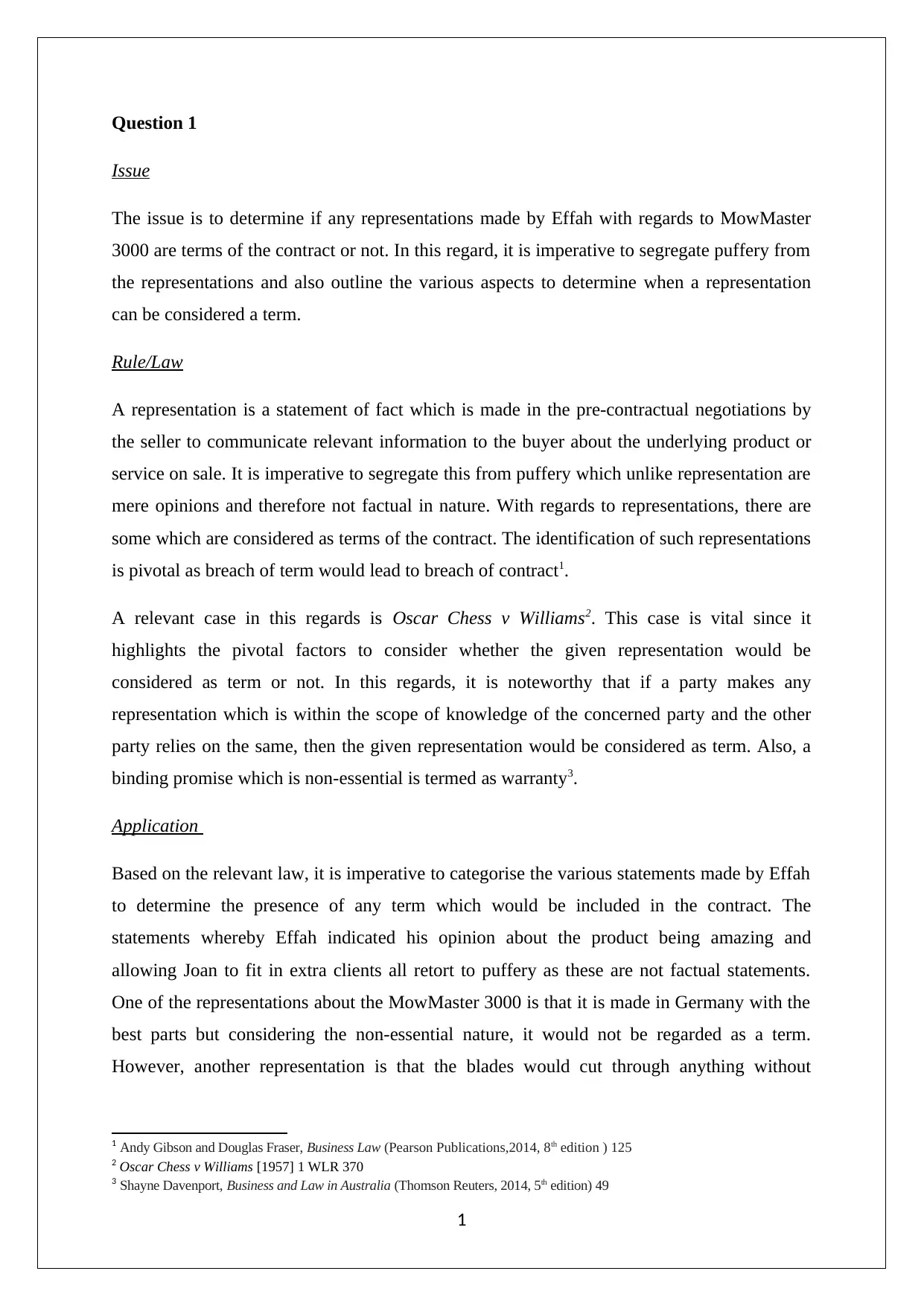
Question 1
Issue
The issue is to determine if any representations made by Effah with regards to MowMaster
3000 are terms of the contract or not. In this regard, it is imperative to segregate puffery from
the representations and also outline the various aspects to determine when a representation
can be considered a term.
Rule/Law
A representation is a statement of fact which is made in the pre-contractual negotiations by
the seller to communicate relevant information to the buyer about the underlying product or
service on sale. It is imperative to segregate this from puffery which unlike representation are
mere opinions and therefore not factual in nature. With regards to representations, there are
some which are considered as terms of the contract. The identification of such representations
is pivotal as breach of term would lead to breach of contract1.
A relevant case in this regards is Oscar Chess v Williams2. This case is vital since it
highlights the pivotal factors to consider whether the given representation would be
considered as term or not. In this regards, it is noteworthy that if a party makes any
representation which is within the scope of knowledge of the concerned party and the other
party relies on the same, then the given representation would be considered as term. Also, a
binding promise which is non-essential is termed as warranty3.
Application
Based on the relevant law, it is imperative to categorise the various statements made by Effah
to determine the presence of any term which would be included in the contract. The
statements whereby Effah indicated his opinion about the product being amazing and
allowing Joan to fit in extra clients all retort to puffery as these are not factual statements.
One of the representations about the MowMaster 3000 is that it is made in Germany with the
best parts but considering the non-essential nature, it would not be regarded as a term.
However, another representation is that the blades would cut through anything without
1 Andy Gibson and Douglas Fraser, Business Law (Pearson Publications,2014, 8th edition ) 125
2 Oscar Chess v Williams [1957] 1 WLR 370
3 Shayne Davenport, Business and Law in Australia (Thomson Reuters, 2014, 5th edition) 49
1
Issue
The issue is to determine if any representations made by Effah with regards to MowMaster
3000 are terms of the contract or not. In this regard, it is imperative to segregate puffery from
the representations and also outline the various aspects to determine when a representation
can be considered a term.
Rule/Law
A representation is a statement of fact which is made in the pre-contractual negotiations by
the seller to communicate relevant information to the buyer about the underlying product or
service on sale. It is imperative to segregate this from puffery which unlike representation are
mere opinions and therefore not factual in nature. With regards to representations, there are
some which are considered as terms of the contract. The identification of such representations
is pivotal as breach of term would lead to breach of contract1.
A relevant case in this regards is Oscar Chess v Williams2. This case is vital since it
highlights the pivotal factors to consider whether the given representation would be
considered as term or not. In this regards, it is noteworthy that if a party makes any
representation which is within the scope of knowledge of the concerned party and the other
party relies on the same, then the given representation would be considered as term. Also, a
binding promise which is non-essential is termed as warranty3.
Application
Based on the relevant law, it is imperative to categorise the various statements made by Effah
to determine the presence of any term which would be included in the contract. The
statements whereby Effah indicated his opinion about the product being amazing and
allowing Joan to fit in extra clients all retort to puffery as these are not factual statements.
One of the representations about the MowMaster 3000 is that it is made in Germany with the
best parts but considering the non-essential nature, it would not be regarded as a term.
However, another representation is that the blades would cut through anything without
1 Andy Gibson and Douglas Fraser, Business Law (Pearson Publications,2014, 8th edition ) 125
2 Oscar Chess v Williams [1957] 1 WLR 370
3 Shayne Davenport, Business and Law in Australia (Thomson Reuters, 2014, 5th edition) 49
1
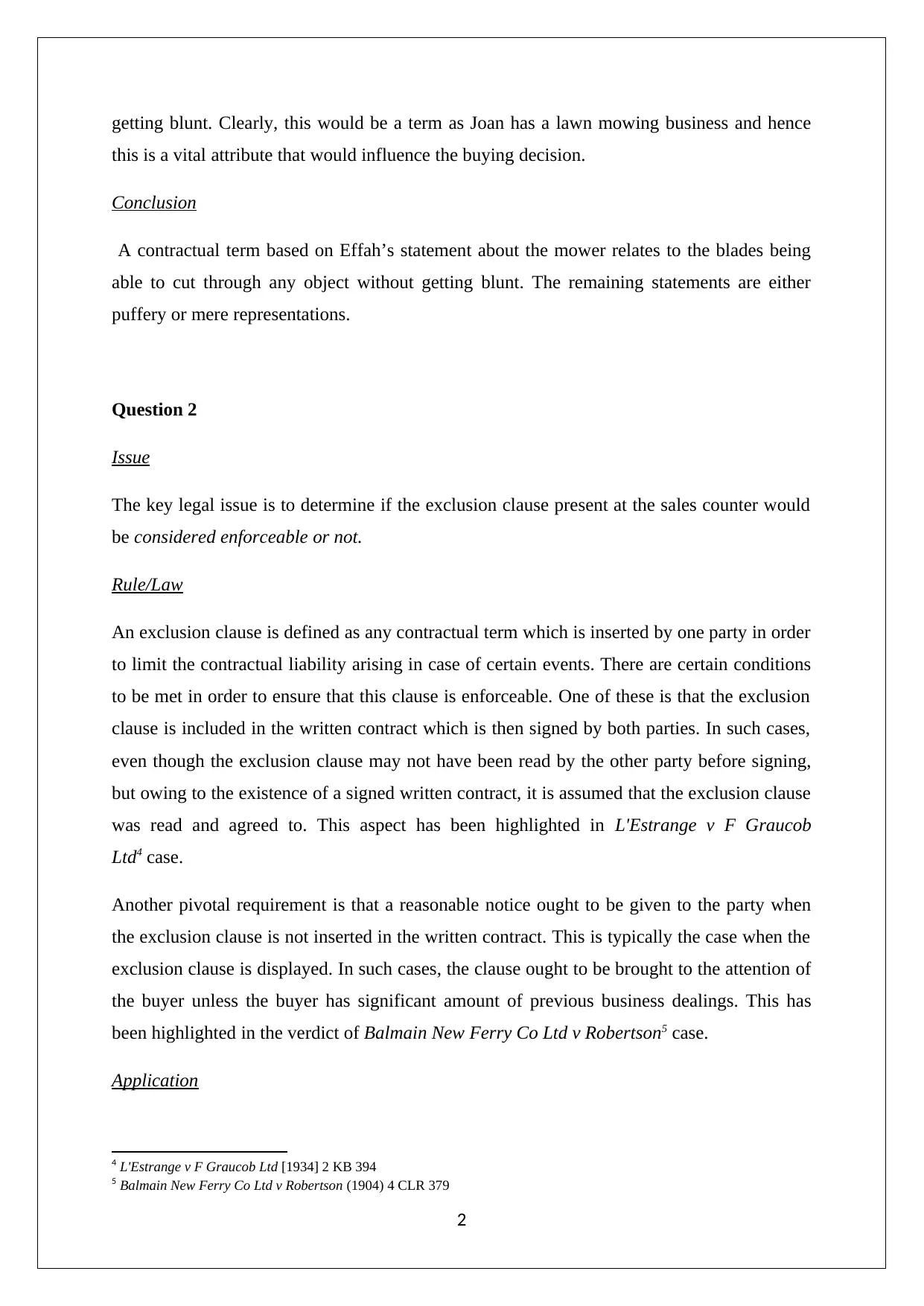
getting blunt. Clearly, this would be a term as Joan has a lawn mowing business and hence
this is a vital attribute that would influence the buying decision.
Conclusion
A contractual term based on Effah’s statement about the mower relates to the blades being
able to cut through any object without getting blunt. The remaining statements are either
puffery or mere representations.
Question 2
Issue
The key legal issue is to determine if the exclusion clause present at the sales counter would
be considered enforceable or not.
Rule/Law
An exclusion clause is defined as any contractual term which is inserted by one party in order
to limit the contractual liability arising in case of certain events. There are certain conditions
to be met in order to ensure that this clause is enforceable. One of these is that the exclusion
clause is included in the written contract which is then signed by both parties. In such cases,
even though the exclusion clause may not have been read by the other party before signing,
but owing to the existence of a signed written contract, it is assumed that the exclusion clause
was read and agreed to. This aspect has been highlighted in L'Estrange v F Graucob
Ltd4 case.
Another pivotal requirement is that a reasonable notice ought to be given to the party when
the exclusion clause is not inserted in the written contract. This is typically the case when the
exclusion clause is displayed. In such cases, the clause ought to be brought to the attention of
the buyer unless the buyer has significant amount of previous business dealings. This has
been highlighted in the verdict of Balmain New Ferry Co Ltd v Robertson5 case.
Application
4 L'Estrange v F Graucob Ltd [1934] 2 KB 394
5 Balmain New Ferry Co Ltd v Robertson (1904) 4 CLR 379
2
this is a vital attribute that would influence the buying decision.
Conclusion
A contractual term based on Effah’s statement about the mower relates to the blades being
able to cut through any object without getting blunt. The remaining statements are either
puffery or mere representations.
Question 2
Issue
The key legal issue is to determine if the exclusion clause present at the sales counter would
be considered enforceable or not.
Rule/Law
An exclusion clause is defined as any contractual term which is inserted by one party in order
to limit the contractual liability arising in case of certain events. There are certain conditions
to be met in order to ensure that this clause is enforceable. One of these is that the exclusion
clause is included in the written contract which is then signed by both parties. In such cases,
even though the exclusion clause may not have been read by the other party before signing,
but owing to the existence of a signed written contract, it is assumed that the exclusion clause
was read and agreed to. This aspect has been highlighted in L'Estrange v F Graucob
Ltd4 case.
Another pivotal requirement is that a reasonable notice ought to be given to the party when
the exclusion clause is not inserted in the written contract. This is typically the case when the
exclusion clause is displayed. In such cases, the clause ought to be brought to the attention of
the buyer unless the buyer has significant amount of previous business dealings. This has
been highlighted in the verdict of Balmain New Ferry Co Ltd v Robertson5 case.
Application
4 L'Estrange v F Graucob Ltd [1934] 2 KB 394
5 Balmain New Ferry Co Ltd v Robertson (1904) 4 CLR 379
2
⊘ This is a preview!⊘
Do you want full access?
Subscribe today to unlock all pages.

Trusted by 1+ million students worldwide
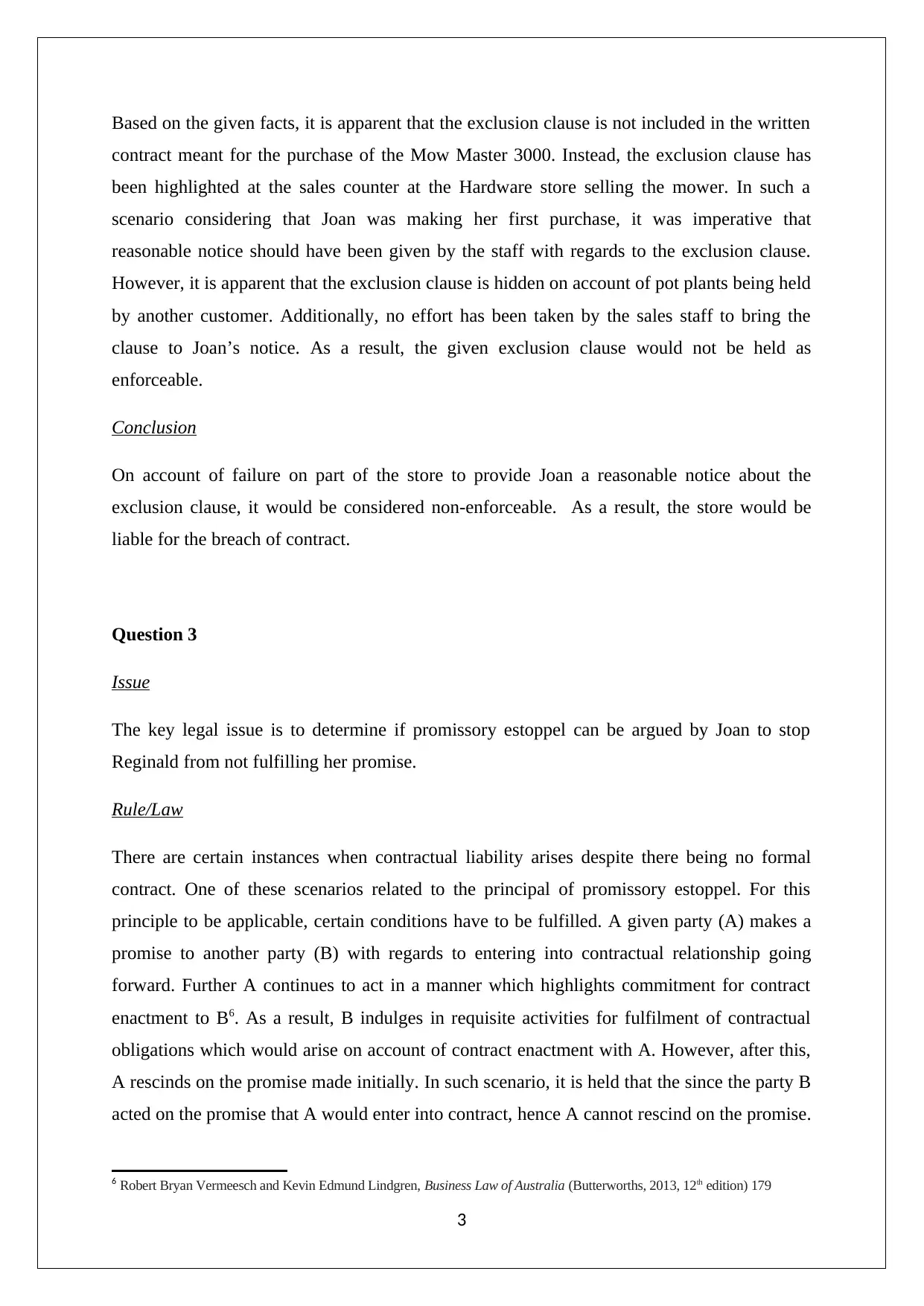
Based on the given facts, it is apparent that the exclusion clause is not included in the written
contract meant for the purchase of the Mow Master 3000. Instead, the exclusion clause has
been highlighted at the sales counter at the Hardware store selling the mower. In such a
scenario considering that Joan was making her first purchase, it was imperative that
reasonable notice should have been given by the staff with regards to the exclusion clause.
However, it is apparent that the exclusion clause is hidden on account of pot plants being held
by another customer. Additionally, no effort has been taken by the sales staff to bring the
clause to Joan’s notice. As a result, the given exclusion clause would not be held as
enforceable.
Conclusion
On account of failure on part of the store to provide Joan a reasonable notice about the
exclusion clause, it would be considered non-enforceable. As a result, the store would be
liable for the breach of contract.
Question 3
Issue
The key legal issue is to determine if promissory estoppel can be argued by Joan to stop
Reginald from not fulfilling her promise.
Rule/Law
There are certain instances when contractual liability arises despite there being no formal
contract. One of these scenarios related to the principal of promissory estoppel. For this
principle to be applicable, certain conditions have to be fulfilled. A given party (A) makes a
promise to another party (B) with regards to entering into contractual relationship going
forward. Further A continues to act in a manner which highlights commitment for contract
enactment to B6. As a result, B indulges in requisite activities for fulfilment of contractual
obligations which would arise on account of contract enactment with A. However, after this,
A rescinds on the promise made initially. In such scenario, it is held that the since the party B
acted on the promise that A would enter into contract, hence A cannot rescind on the promise.
6 Robert Bryan Vermeesch and Kevin Edmund Lindgren, Business Law of Australia (Butterworths, 2013, 12th edition) 179
3
contract meant for the purchase of the Mow Master 3000. Instead, the exclusion clause has
been highlighted at the sales counter at the Hardware store selling the mower. In such a
scenario considering that Joan was making her first purchase, it was imperative that
reasonable notice should have been given by the staff with regards to the exclusion clause.
However, it is apparent that the exclusion clause is hidden on account of pot plants being held
by another customer. Additionally, no effort has been taken by the sales staff to bring the
clause to Joan’s notice. As a result, the given exclusion clause would not be held as
enforceable.
Conclusion
On account of failure on part of the store to provide Joan a reasonable notice about the
exclusion clause, it would be considered non-enforceable. As a result, the store would be
liable for the breach of contract.
Question 3
Issue
The key legal issue is to determine if promissory estoppel can be argued by Joan to stop
Reginald from not fulfilling her promise.
Rule/Law
There are certain instances when contractual liability arises despite there being no formal
contract. One of these scenarios related to the principal of promissory estoppel. For this
principle to be applicable, certain conditions have to be fulfilled. A given party (A) makes a
promise to another party (B) with regards to entering into contractual relationship going
forward. Further A continues to act in a manner which highlights commitment for contract
enactment to B6. As a result, B indulges in requisite activities for fulfilment of contractual
obligations which would arise on account of contract enactment with A. However, after this,
A rescinds on the promise made initially. In such scenario, it is held that the since the party B
acted on the promise that A would enter into contract, hence A cannot rescind on the promise.
6 Robert Bryan Vermeesch and Kevin Edmund Lindgren, Business Law of Australia (Butterworths, 2013, 12th edition) 179
3
Paraphrase This Document
Need a fresh take? Get an instant paraphrase of this document with our AI Paraphraser
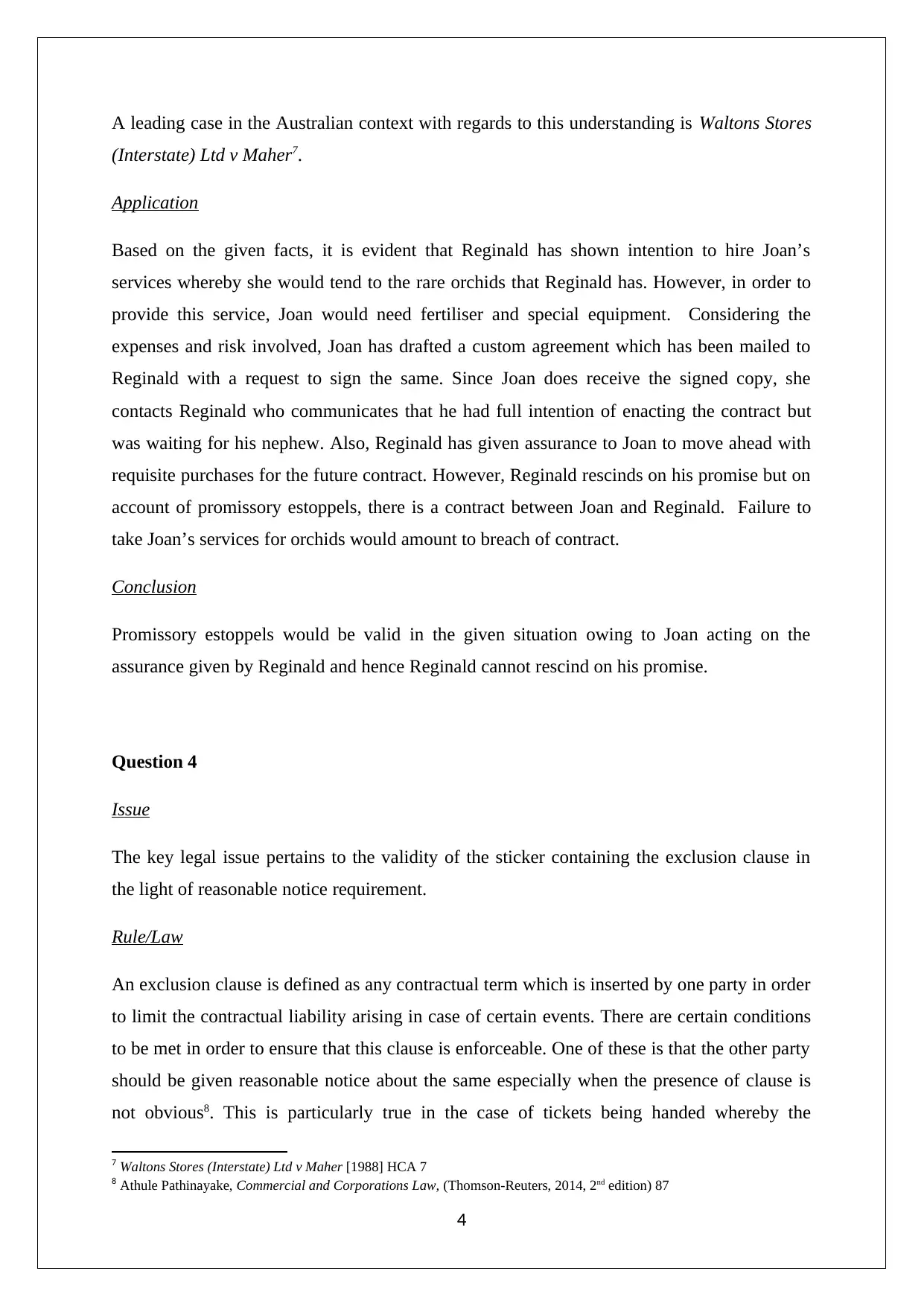
A leading case in the Australian context with regards to this understanding is Waltons Stores
(Interstate) Ltd v Maher7.
Application
Based on the given facts, it is evident that Reginald has shown intention to hire Joan’s
services whereby she would tend to the rare orchids that Reginald has. However, in order to
provide this service, Joan would need fertiliser and special equipment. Considering the
expenses and risk involved, Joan has drafted a custom agreement which has been mailed to
Reginald with a request to sign the same. Since Joan does receive the signed copy, she
contacts Reginald who communicates that he had full intention of enacting the contract but
was waiting for his nephew. Also, Reginald has given assurance to Joan to move ahead with
requisite purchases for the future contract. However, Reginald rescinds on his promise but on
account of promissory estoppels, there is a contract between Joan and Reginald. Failure to
take Joan’s services for orchids would amount to breach of contract.
Conclusion
Promissory estoppels would be valid in the given situation owing to Joan acting on the
assurance given by Reginald and hence Reginald cannot rescind on his promise.
Question 4
Issue
The key legal issue pertains to the validity of the sticker containing the exclusion clause in
the light of reasonable notice requirement.
Rule/Law
An exclusion clause is defined as any contractual term which is inserted by one party in order
to limit the contractual liability arising in case of certain events. There are certain conditions
to be met in order to ensure that this clause is enforceable. One of these is that the other party
should be given reasonable notice about the same especially when the presence of clause is
not obvious8. This is particularly true in the case of tickets being handed whereby the
7 Waltons Stores (Interstate) Ltd v Maher [1988] HCA 7
8 Athule Pathinayake, Commercial and Corporations Law, (Thomson-Reuters, 2014, 2nd edition) 87
4
(Interstate) Ltd v Maher7.
Application
Based on the given facts, it is evident that Reginald has shown intention to hire Joan’s
services whereby she would tend to the rare orchids that Reginald has. However, in order to
provide this service, Joan would need fertiliser and special equipment. Considering the
expenses and risk involved, Joan has drafted a custom agreement which has been mailed to
Reginald with a request to sign the same. Since Joan does receive the signed copy, she
contacts Reginald who communicates that he had full intention of enacting the contract but
was waiting for his nephew. Also, Reginald has given assurance to Joan to move ahead with
requisite purchases for the future contract. However, Reginald rescinds on his promise but on
account of promissory estoppels, there is a contract between Joan and Reginald. Failure to
take Joan’s services for orchids would amount to breach of contract.
Conclusion
Promissory estoppels would be valid in the given situation owing to Joan acting on the
assurance given by Reginald and hence Reginald cannot rescind on his promise.
Question 4
Issue
The key legal issue pertains to the validity of the sticker containing the exclusion clause in
the light of reasonable notice requirement.
Rule/Law
An exclusion clause is defined as any contractual term which is inserted by one party in order
to limit the contractual liability arising in case of certain events. There are certain conditions
to be met in order to ensure that this clause is enforceable. One of these is that the other party
should be given reasonable notice about the same especially when the presence of clause is
not obvious8. This is particularly true in the case of tickets being handed whereby the
7 Waltons Stores (Interstate) Ltd v Maher [1988] HCA 7
8 Athule Pathinayake, Commercial and Corporations Law, (Thomson-Reuters, 2014, 2nd edition) 87
4
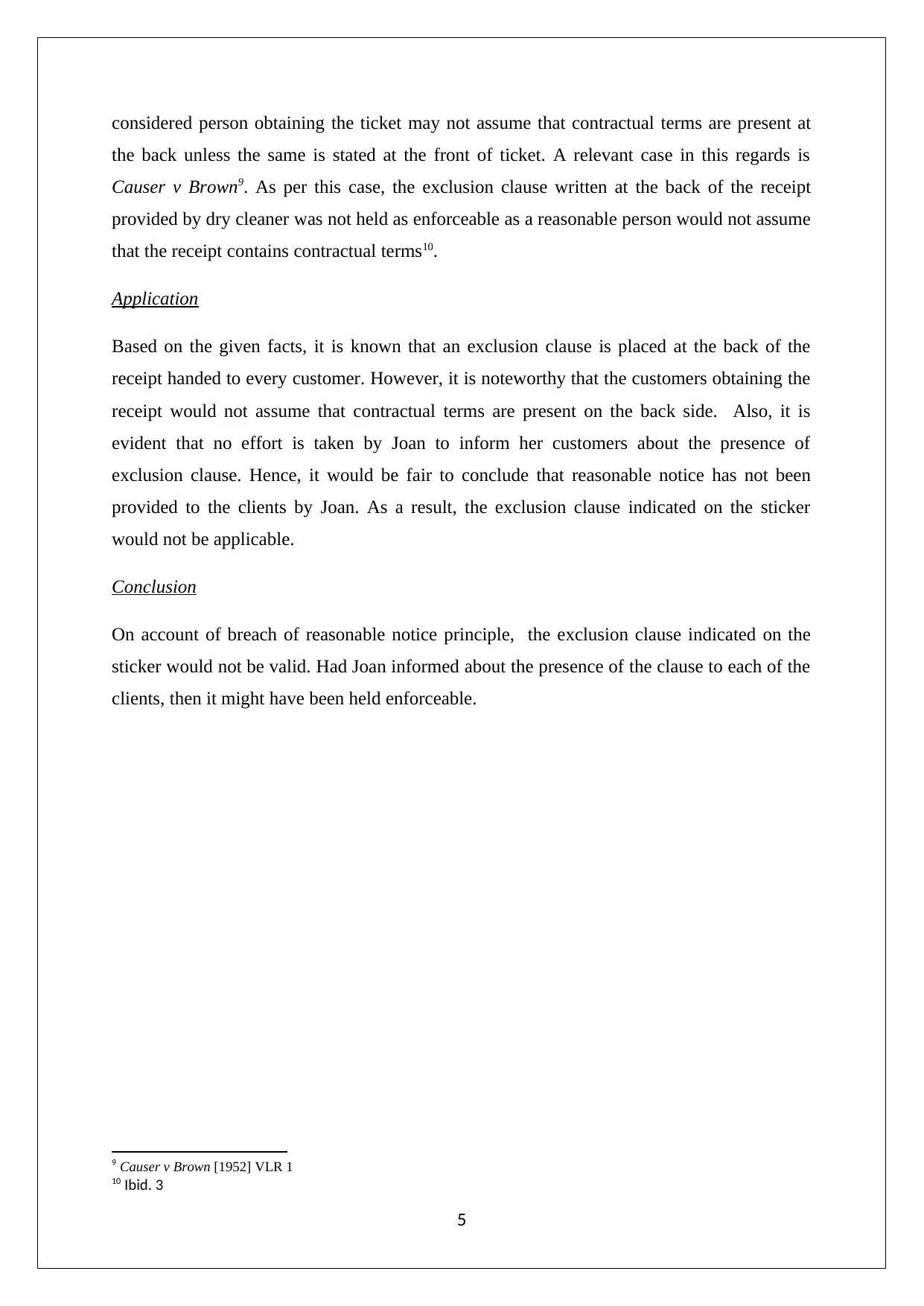
considered person obtaining the ticket may not assume that contractual terms are present at
the back unless the same is stated at the front of ticket. A relevant case in this regards is
Causer v Brown9. As per this case, the exclusion clause written at the back of the receipt
provided by dry cleaner was not held as enforceable as a reasonable person would not assume
that the receipt contains contractual terms10.
Application
Based on the given facts, it is known that an exclusion clause is placed at the back of the
receipt handed to every customer. However, it is noteworthy that the customers obtaining the
receipt would not assume that contractual terms are present on the back side. Also, it is
evident that no effort is taken by Joan to inform her customers about the presence of
exclusion clause. Hence, it would be fair to conclude that reasonable notice has not been
provided to the clients by Joan. As a result, the exclusion clause indicated on the sticker
would not be applicable.
Conclusion
On account of breach of reasonable notice principle, the exclusion clause indicated on the
sticker would not be valid. Had Joan informed about the presence of the clause to each of the
clients, then it might have been held enforceable.
9 Causer v Brown [1952] VLR 1
10 Ibid. 3
5
the back unless the same is stated at the front of ticket. A relevant case in this regards is
Causer v Brown9. As per this case, the exclusion clause written at the back of the receipt
provided by dry cleaner was not held as enforceable as a reasonable person would not assume
that the receipt contains contractual terms10.
Application
Based on the given facts, it is known that an exclusion clause is placed at the back of the
receipt handed to every customer. However, it is noteworthy that the customers obtaining the
receipt would not assume that contractual terms are present on the back side. Also, it is
evident that no effort is taken by Joan to inform her customers about the presence of
exclusion clause. Hence, it would be fair to conclude that reasonable notice has not been
provided to the clients by Joan. As a result, the exclusion clause indicated on the sticker
would not be applicable.
Conclusion
On account of breach of reasonable notice principle, the exclusion clause indicated on the
sticker would not be valid. Had Joan informed about the presence of the clause to each of the
clients, then it might have been held enforceable.
9 Causer v Brown [1952] VLR 1
10 Ibid. 3
5
⊘ This is a preview!⊘
Do you want full access?
Subscribe today to unlock all pages.

Trusted by 1+ million students worldwide
1 out of 6
Related Documents
Your All-in-One AI-Powered Toolkit for Academic Success.
+13062052269
info@desklib.com
Available 24*7 on WhatsApp / Email
![[object Object]](/_next/static/media/star-bottom.7253800d.svg)
Unlock your academic potential
Copyright © 2020–2025 A2Z Services. All Rights Reserved. Developed and managed by ZUCOL.
![Detailed Case Analysis: Contract Law Issues in Business - [Module]](/_next/image/?url=https%3A%2F%2Fdesklib.com%2Fmedia%2Fimages%2Fbp%2F21fe1e6ab8ee47e1b904ddfd70315544.jpg&w=256&q=75)




